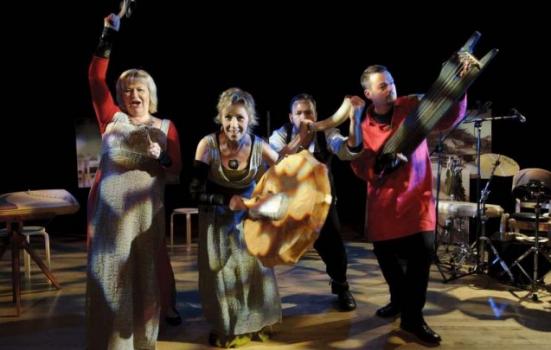Selling new work to audiences and venues can be difficult enough, but how do you sell a new artform like storytelling? Naomi Wilds explains how Adverse Camber has faced up to the challenge.

What does a ticket for a storytelling production get you? It’s not for children, but doesn’t exclude children. It’s not theatre, dance, music or spoken word, but can encompass elements of them all.
Audience responses and our growing network of venues tell us after a decade of toil that something is building
Adverse Camber has been touring England, Wales and Scotland with epic stories steeped in hundreds or thousands of years of culture for the past ten years. Last year we toured two shows: Fire in the North Sky, stories drawn from Finland’s national epic ‘The Kalevala’; and ‘The Shahnameh’, the national poem of Iran. Both are tales that span the ages and different cultures. Storytelling respects no borders and neither, as a company, do we.
Overcoming barriers
Like all artforms in a similar position, overcoming barriers to understanding takes continued belief and extra hard work. Audience feedback helps propel our vision forwards. 40% of our audiences are seeing storytelling for the first time, and 88% give the work the top rating for quality.
There’s an overwhelming strength of feeling in the feedback, including being surprised, even shocked, by their experience with us. One audience member said: “I was amazed to find performers of such awesome stature and a show which was at once fun and academic, while maintaining a degree of improvisation.”
National newspapers don’t have a storytelling correspondent and there isn’t a ‘Top five storytelling events’ in the weekend entertainment supplements. The experience and quality of the work often goes without that third-party, public validation that the arts sector often uses as an essential barometer.
The voices of our audiences are especially important and we increasingly open up creative processes to them in the early stages. Their feedback keeps us bold, pushing at the boundaries of the form in how we present and support it.
Venues and audiences
Festivals and forward-thinking arts venues are the best friends we could hope for. We understand that we ask them to take a risk the first time they book us, so we go the extra mile to repay their faith. Our marketing manager shares our vision with each venue, undertaking marketing share days that stretch our resources but seem wholly appropriate and are thankfully effective.
We allocate some of our budget to test audience development ideas together. Venues reap rewards and so do we. In 2015, two venues new that were new to our work reported 56% and 70% first-time attenders through their doors.
We aim to reach as varied an audience as possible and so embrace a diversity of partnerships. Festivals position us in cultural spaces that are building storytelling or literary audiences, boosting artform confidence.
Taking storytelling to diverse towns and cities is where arts centres can come into their own. Occasionally maligned, perhaps misused at times, but a beacon for us, permanent arts spaces have staff who genuinely care, who can provide marketing expertise, a box office infrastructure, technical know-how and nurtured relationships with their communities.
Sometimes venues misunderstand us: “We’ll programme it in the school holidays.” Frequently, they share our concerns: “It’s great, but we’re worried about attracting audiences.” We’re always shouldering joint risk – not easy, but worth the effort.
Alongside repeat visits to a varied list of venues, from Sage Gateshead to Margate Theatre Royal, and rural touring, we’ve grown strategic, co-commissioning partnerships with mac Birmingham, Derby LIVE and Beyond the Border Festival in Wales. These relationships have enabled us to commission ambitious, internationally collaborative work.
A global movement
Traditional storytelling, as steeped as it is in history, comes with baggage. For us it means the occasional resistance to moving beyond supposed ‘natural’ settings into progressive, urban arts venues that are important to us and our funders.
We operate in a globally connected and increasingly digitised world. We can’t exist in a state of nostalgia. Our artists believe it’s possible to make something new, while respecting long traditions. Audience responses and our growing network of venues tell us after a decade of toil that something is building.
With millennia of storytelling behind us, it’s important to recognise we’re part of a global movement, not the whole solution. We do what’s in our power to bring about the change we’d like to see, taking time to develop and nurture artists and spend time with programmers and marketers to make us all advocates for the experience of storytelling. It’s a race of endurance, not a sprint.
For any individual or organisation striving to reorientate people’s perceptions, there are unpredictable hurdles to contend with, all of which need confidence, resilience, adaptability, innovation, hard work, friendliness, our courageous funders and an entrepreneurial spirit to deal with.
Naomi Wilds is Producer at Adverse Camber.
www.adversecamber.org




